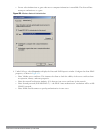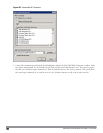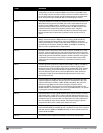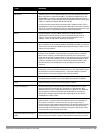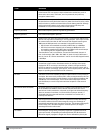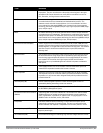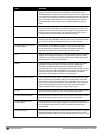
864 | Acronymsand Terms DellPowerConnectW-SeriesArubaOS6.2 | User Guide
Term Definition
Configuration can be fine-tuned at the Media Access Control layer (MAC layer)
level to comply with the rules of the country or district in which the network is to
be used. Rules subject to variation include allowed frequencies, allowed power
levels, and allowed signal bandwidth. 802.11d facilitates global roaming.
802.11e A proposed adaptation to the 802.11a and 802.11b specifications that enhances the
802.11 Media Access Control layer (MAC layer) with a coordinated time division
multiple access (TDMA) construct, and adds error-correcting mechanisms for
delay-sensitive applications such as voice and video. The 802.11e specification
provides seamless interoperability between business, home, and public
environments such as airports and hotels and offers all subscribers high-speed
Internet access with full-motion video, high-fidelity audio, and Voice over IP
(VoIP).
802.11g Offers transmission over relatively short distances at up to 54 megabits per second
(Mbps), compared with the 11 Mbps theoretical maximum of 802.11b. 802.11g
employs orthogonal frequency division multiplexing (OFDM), the modulation
scheme used in 802.11a, to obtain higher data speed. Computers or terminals set
up for 802.11g can fall back to speeds of 11 Mbps, so that 802.11b and 802.11g
devices can be compatible within a single network.
802.11h Intended to resolve interference issues introduced by the use of 802.11a in some
locations, particularly with military radar systems and medical devices. Dynamic
frequency selection (DFS) detects the presence of other devices on a channel and
automatically switches the network to another channel if and when such signals
are detected. Transmit power control (TPC) reduces the radio-frequency (RF)
output power of each network transmitter to a level that minimizes the risk of
interference.
802.11i Provides improved encryption for networks that use 802.11a, 802.11b, and 802.11g
standards. Requires new encryption key protocols, known as Temporal Key
Integrity Protocol (TKIP) and Advanced Encryption Standard (AES). Other features
include key caching, which facilitates fast reconnection to the server for users
who have temporarily gone offline, and pre-authentication, which allows fast
roaming and is ideal for use with advanced applications such as Voice over
Internet Protocol (VoIP).
802.11j Proposed addition to the 802.11 family of standards that incorporates Japanese
regulatory extensions to 802.11a; the main intent is to add channels in the radio-
frequency (RF) band of 4.9 GHz to 5.0 GHz. WLANs using 802.11j will provide for
speeds of up to 54 Mbps, and will employ orthogonal frequency division
multiplexing (OFDM). The specification will define how Japanese 802.11 family
WLANs and other wireless systems, particularly HiperLAN2 networks, can operate
in geographic proximity without mutual interference.
802.11k Proposed standard for how a WLAN should perform channel selection, roaming,
and transmit power control (TPC) in order to optimize network performance. In a
network conforming to 802.11k, if the access point (AP) having the strongest signal
is loaded to capacity, a wireless device is connected to one of the underutilized
APs. Even though the signal may be weaker, the overall throughput is greater
because more efficient use is made of the network resources.
802.11n Wireless networking standard to improve network throughput over the two
previous standards 802.11a and 802.11g with a significant increase in the maximum
raw data rate from 54 Mbit/s to 600 Mbit/s with the use of four spatial streams at a
channel width of 40 MHz.
802.11m An initiative to perform editorial maintenance, corrections, improvements,



